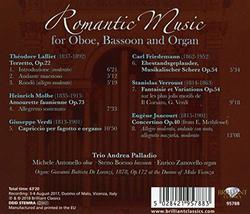| All Artists: Trio Andrea Palladio Title: Trio Andrea Palladio: Romantic Music for Oboe, Bassoon & Organ Members Wishing: 0 Total Copies: 0 Label: Brilliant Records Release Date: 11/9/2018 Genre: Classical Style: Chamber Music Number of Discs: 1 SwapaCD Credits: 1 |
Search - Trio Andrea Palladio :: Trio Andrea Palladio: Romantic Music for Oboe, Bassoon & Organ
 | Trio Andrea Palladio Trio Andrea Palladio: Romantic Music for Oboe, Bassoon & Organ Genre: Classical Musicians desire to improve the agility and power of their instruments has always tended to go hand in hand with technological development: we may think of Bach and his organ and Beethoven and his piano as well as performe... more » |
Larger Image |
CD Details
Synopsis
Product Description
Musicians desire to improve the agility and power of their instruments has always tended to go hand in hand with technological development: we may think of Bach and his organ and Beethoven and his piano as well as performer-composers such as Paganini and, in our own time, Jörg Widmann. Through the course of the 19th century the organ was also evolving, transcending the image of an exclusively liturgical instrument and gaining ground and indeed range of tone-colors in concertante roles. Another 19th-century case in point was Eugène Jancourt, the bassoon virtuoso and composer, who brought about important changes in his instrument in order to extend its expressive potential. A longstanding performer and teacher at the Paris Conservatoire, he wrote a Concertino which transfers well to this combination of bassoon and organ, as does a Verdian rarity, discovered as recently as 2001, the youthful Capriccio. A contemporary of Jancourts was the French oboist, composer and conductor Théodore Lalliet, who played solo oboe in the orchestra of the Paris Opera. His Op.22 Terzetto was conceived as a piano trio, but the fluid instrumental dialogue gains an attractive mellifluousness in this combination of oboe, bassoon and organ. Ehestandsgeplauder (Wedding Chatter) by Carl Friedemann and Amourette faunienne by Heinrich Molbe are lighter occasional pieces. Verdis Capriccio is complemented here by the inclusion of the Fantasie et Variations for oboe on themes of Il Corsaro. Its composer, Stanislas Verroust, studied music in Paris, where he then made a name for himself as an oboist and violinist as well as composing for the oboe and devoting time to teaching. This combination of repertoire is unrivalled in the catalogue. The recording was made in 2017 at the cathedral in Vicenza, which hosts an organ built by Giovanni Battista De Lorenzi in 1878, replete with the technical innovations that enable rapid execution of the quicksilver shifts in volume and tone-color demanded by this music.
